Continuity of Care: The Physician Associate's Role in Patient Outcome
VerifiedAdded on 2023/05/24
|86
|26183
|266
Thesis and Dissertation
AI Summary
This dissertation investigates the importance and benefits of Continuity of Care (CoC) in primary care settings, focusing on its impact on patient outcomes and the role of Physician Associates (PAs) within multidisciplinary teams (MDTs). It uses a qualitative approach with thematic analysis of 25 articles to identify key themes, including the significance and advantages of CoC, the role of PAs in MDTs, and their contribution to delivering CoC for improved healthcare outcomes. The study highlights that CoC reduces mortality rates and enhances patient satisfaction, while PAs are essential in MDTs to ensure CoC by reducing physician workload. The research concludes with recommendations for integrating PAs more effectively into primary care to improve patient care quality and outcomes.

1
Running Head: DISSERTATION
“The importance and benefits of Continuity of Care in primary care settings in relation to patient
outcome, and the role the Physician Associate can play in a multi-disciplinary team.”
[Name of the Writer]
[Name of the Institute]
Running Head: DISSERTATION
“The importance and benefits of Continuity of Care in primary care settings in relation to patient
outcome, and the role the Physician Associate can play in a multi-disciplinary team.”
[Name of the Writer]
[Name of the Institute]
Paraphrase This Document
Need a fresh take? Get an instant paraphrase of this document with our AI Paraphraser
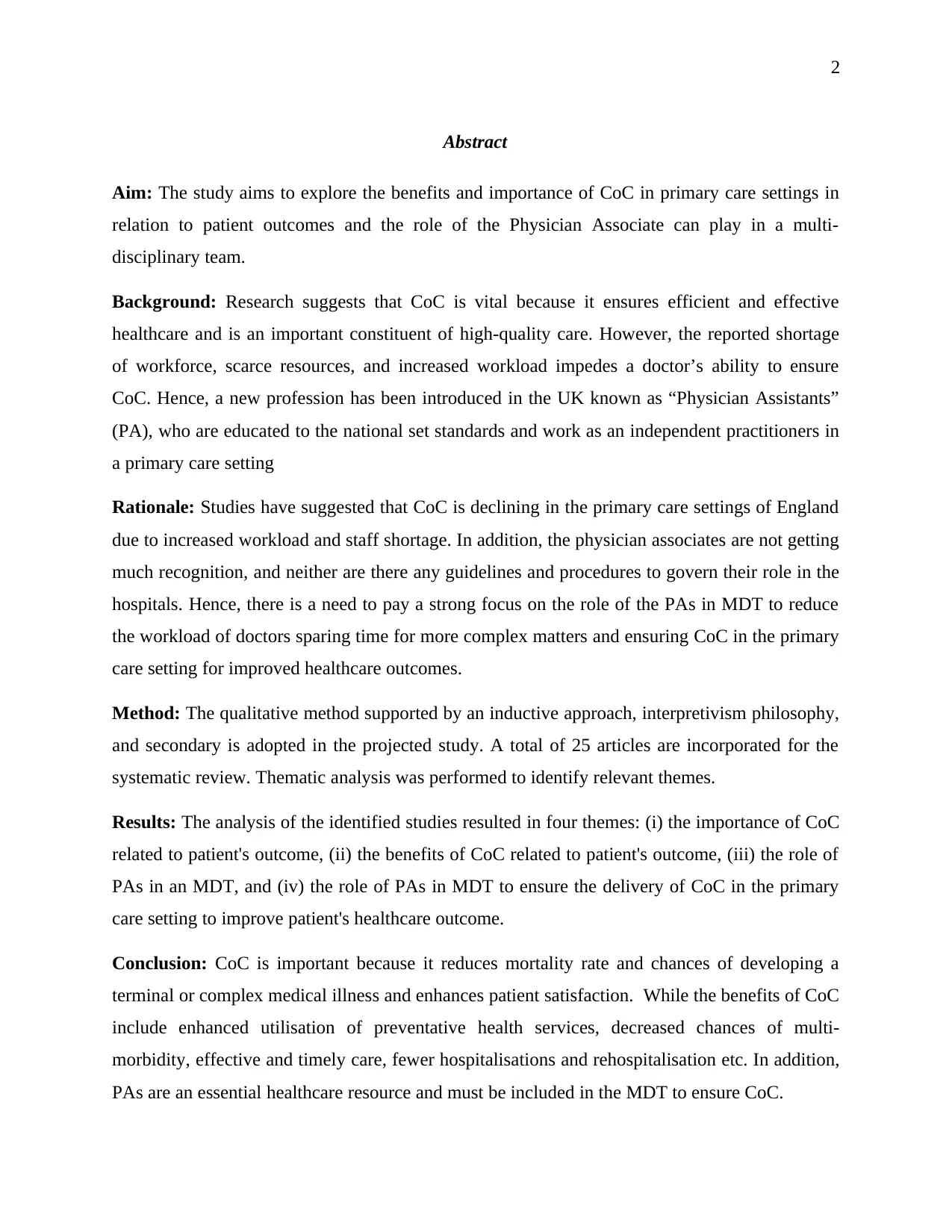
2
Abstract
Aim: The study aims to explore the benefits and importance of CoC in primary care settings in
relation to patient outcomes and the role of the Physician Associate can play in a multi-
disciplinary team.
Background: Research suggests that CoC is vital because it ensures efficient and effective
healthcare and is an important constituent of high-quality care. However, the reported shortage
of workforce, scarce resources, and increased workload impedes a doctor’s ability to ensure
CoC. Hence, a new profession has been introduced in the UK known as “Physician Assistants”
(PA), who are educated to the national set standards and work as an independent practitioners in
a primary care setting
Rationale: Studies have suggested that CoC is declining in the primary care settings of England
due to increased workload and staff shortage. In addition, the physician associates are not getting
much recognition, and neither are there any guidelines and procedures to govern their role in the
hospitals. Hence, there is a need to pay a strong focus on the role of the PAs in MDT to reduce
the workload of doctors sparing time for more complex matters and ensuring CoC in the primary
care setting for improved healthcare outcomes.
Method: The qualitative method supported by an inductive approach, interpretivism philosophy,
and secondary is adopted in the projected study. A total of 25 articles are incorporated for the
systematic review. Thematic analysis was performed to identify relevant themes.
Results: The analysis of the identified studies resulted in four themes: (i) the importance of CoC
related to patient's outcome, (ii) the benefits of CoC related to patient's outcome, (iii) the role of
PAs in an MDT, and (iv) the role of PAs in MDT to ensure the delivery of CoC in the primary
care setting to improve patient's healthcare outcome.
Conclusion: CoC is important because it reduces mortality rate and chances of developing a
terminal or complex medical illness and enhances patient satisfaction. While the benefits of CoC
include enhanced utilisation of preventative health services, decreased chances of multi-
morbidity, effective and timely care, fewer hospitalisations and rehospitalisation etc. In addition,
PAs are an essential healthcare resource and must be included in the MDT to ensure CoC.
Abstract
Aim: The study aims to explore the benefits and importance of CoC in primary care settings in
relation to patient outcomes and the role of the Physician Associate can play in a multi-
disciplinary team.
Background: Research suggests that CoC is vital because it ensures efficient and effective
healthcare and is an important constituent of high-quality care. However, the reported shortage
of workforce, scarce resources, and increased workload impedes a doctor’s ability to ensure
CoC. Hence, a new profession has been introduced in the UK known as “Physician Assistants”
(PA), who are educated to the national set standards and work as an independent practitioners in
a primary care setting
Rationale: Studies have suggested that CoC is declining in the primary care settings of England
due to increased workload and staff shortage. In addition, the physician associates are not getting
much recognition, and neither are there any guidelines and procedures to govern their role in the
hospitals. Hence, there is a need to pay a strong focus on the role of the PAs in MDT to reduce
the workload of doctors sparing time for more complex matters and ensuring CoC in the primary
care setting for improved healthcare outcomes.
Method: The qualitative method supported by an inductive approach, interpretivism philosophy,
and secondary is adopted in the projected study. A total of 25 articles are incorporated for the
systematic review. Thematic analysis was performed to identify relevant themes.
Results: The analysis of the identified studies resulted in four themes: (i) the importance of CoC
related to patient's outcome, (ii) the benefits of CoC related to patient's outcome, (iii) the role of
PAs in an MDT, and (iv) the role of PAs in MDT to ensure the delivery of CoC in the primary
care setting to improve patient's healthcare outcome.
Conclusion: CoC is important because it reduces mortality rate and chances of developing a
terminal or complex medical illness and enhances patient satisfaction. While the benefits of CoC
include enhanced utilisation of preventative health services, decreased chances of multi-
morbidity, effective and timely care, fewer hospitalisations and rehospitalisation etc. In addition,
PAs are an essential healthcare resource and must be included in the MDT to ensure CoC.
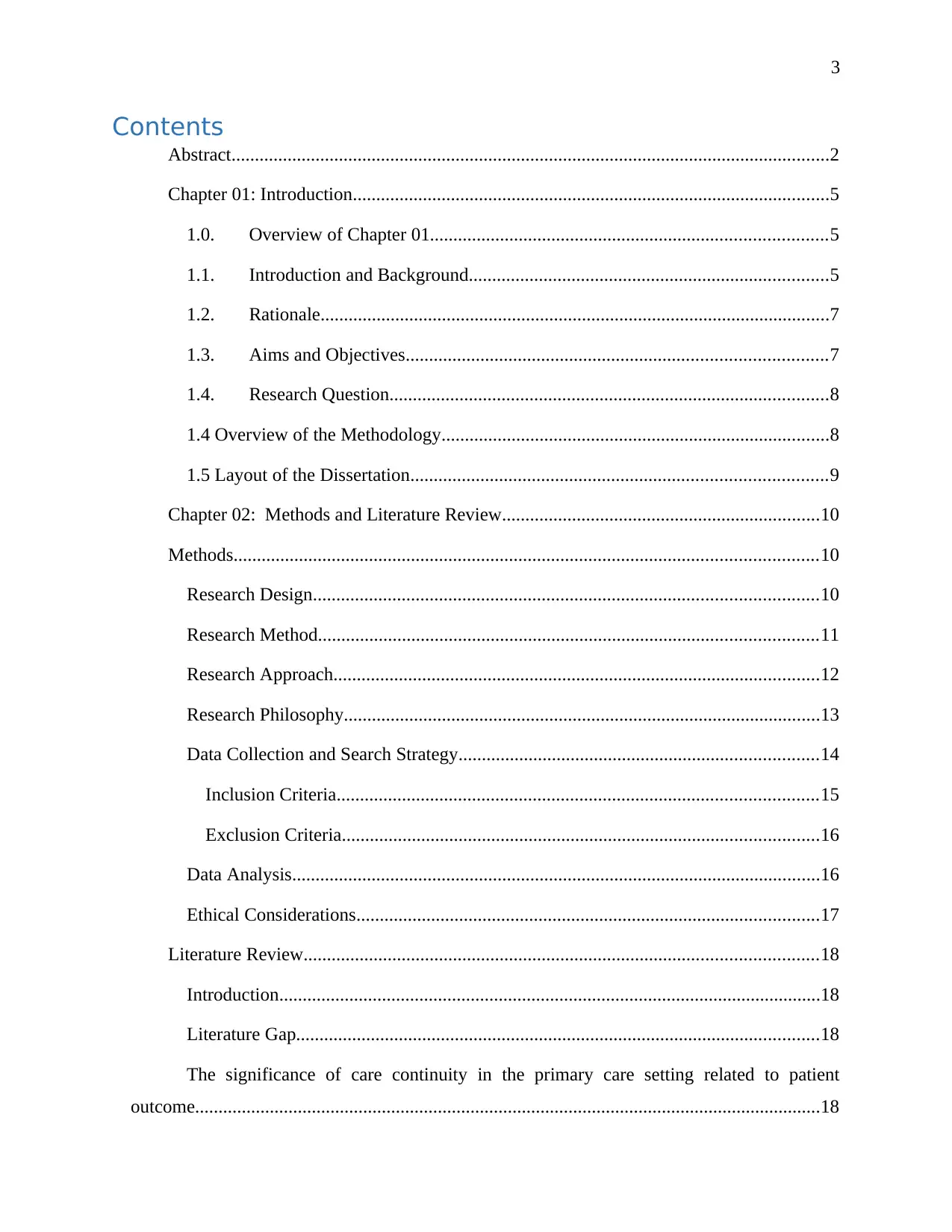
3
Contents
Abstract................................................................................................................................2
Chapter 01: Introduction......................................................................................................5
1.0. Overview of Chapter 01.....................................................................................5
1.1. Introduction and Background.............................................................................5
1.2. Rationale.............................................................................................................7
1.3. Aims and Objectives..........................................................................................7
1.4. Research Question..............................................................................................8
1.4 Overview of the Methodology...................................................................................8
1.5 Layout of the Dissertation.........................................................................................9
Chapter 02: Methods and Literature Review....................................................................10
Methods.............................................................................................................................10
Research Design............................................................................................................10
Research Method...........................................................................................................11
Research Approach........................................................................................................12
Research Philosophy......................................................................................................13
Data Collection and Search Strategy.............................................................................14
Inclusion Criteria.......................................................................................................15
Exclusion Criteria......................................................................................................16
Data Analysis.................................................................................................................16
Ethical Considerations...................................................................................................17
Literature Review..............................................................................................................18
Introduction....................................................................................................................18
Literature Gap................................................................................................................18
The significance of care continuity in the primary care setting related to patient
outcome......................................................................................................................................18
Contents
Abstract................................................................................................................................2
Chapter 01: Introduction......................................................................................................5
1.0. Overview of Chapter 01.....................................................................................5
1.1. Introduction and Background.............................................................................5
1.2. Rationale.............................................................................................................7
1.3. Aims and Objectives..........................................................................................7
1.4. Research Question..............................................................................................8
1.4 Overview of the Methodology...................................................................................8
1.5 Layout of the Dissertation.........................................................................................9
Chapter 02: Methods and Literature Review....................................................................10
Methods.............................................................................................................................10
Research Design............................................................................................................10
Research Method...........................................................................................................11
Research Approach........................................................................................................12
Research Philosophy......................................................................................................13
Data Collection and Search Strategy.............................................................................14
Inclusion Criteria.......................................................................................................15
Exclusion Criteria......................................................................................................16
Data Analysis.................................................................................................................16
Ethical Considerations...................................................................................................17
Literature Review..............................................................................................................18
Introduction....................................................................................................................18
Literature Gap................................................................................................................18
The significance of care continuity in the primary care setting related to patient
outcome......................................................................................................................................18
⊘ This is a preview!⊘
Do you want full access?
Subscribe today to unlock all pages.

Trusted by 1+ million students worldwide
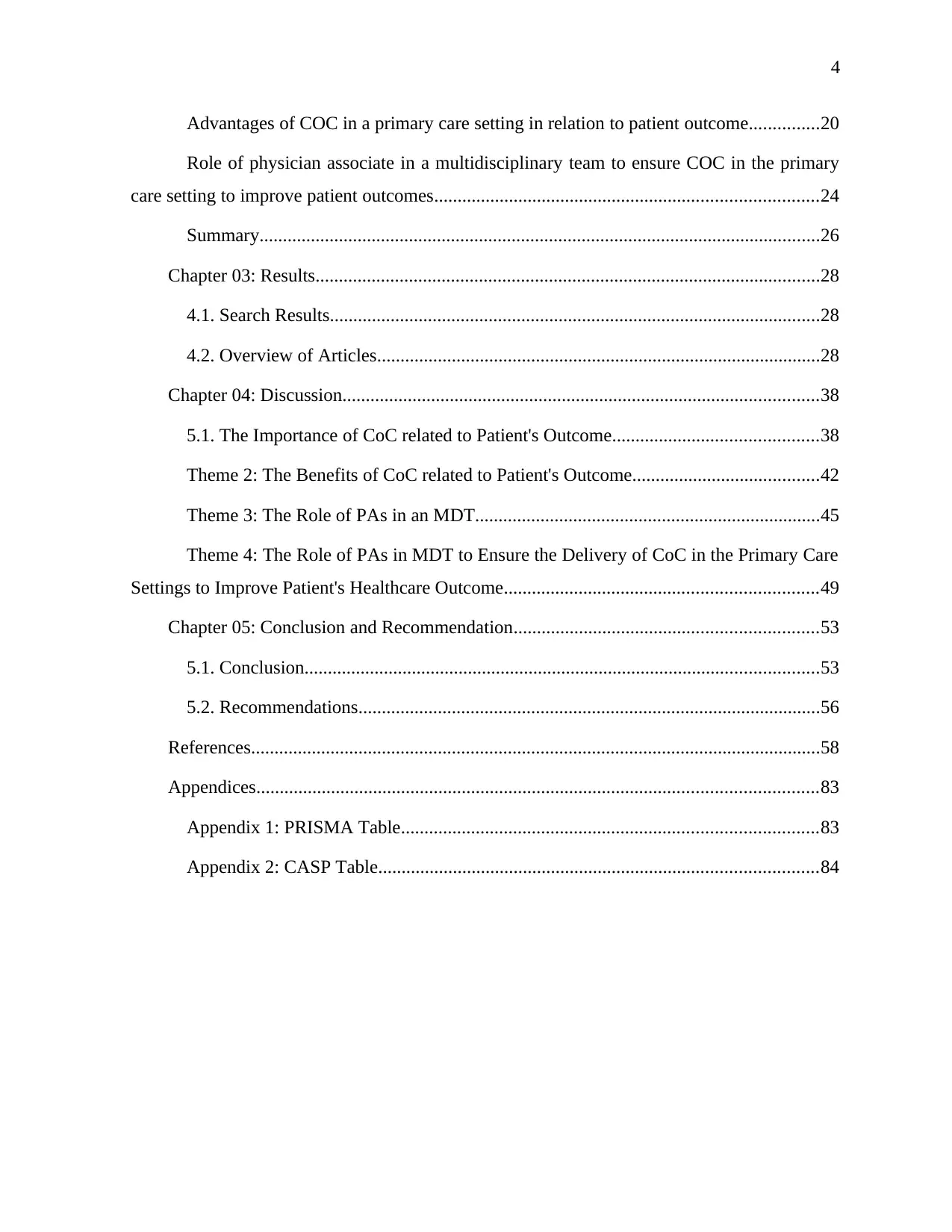
4
Advantages of COC in a primary care setting in relation to patient outcome...............20
Role of physician associate in a multidisciplinary team to ensure COC in the primary
care setting to improve patient outcomes..................................................................................24
Summary........................................................................................................................26
Chapter 03: Results............................................................................................................28
4.1. Search Results.........................................................................................................28
4.2. Overview of Articles...............................................................................................28
Chapter 04: Discussion......................................................................................................38
5.1. The Importance of CoC related to Patient's Outcome............................................38
Theme 2: The Benefits of CoC related to Patient's Outcome........................................42
Theme 3: The Role of PAs in an MDT..........................................................................45
Theme 4: The Role of PAs in MDT to Ensure the Delivery of CoC in the Primary Care
Settings to Improve Patient's Healthcare Outcome...................................................................49
Chapter 05: Conclusion and Recommendation.................................................................53
5.1. Conclusion..............................................................................................................53
5.2. Recommendations...................................................................................................56
References..........................................................................................................................58
Appendices........................................................................................................................83
Appendix 1: PRISMA Table.........................................................................................83
Appendix 2: CASP Table..............................................................................................84
Advantages of COC in a primary care setting in relation to patient outcome...............20
Role of physician associate in a multidisciplinary team to ensure COC in the primary
care setting to improve patient outcomes..................................................................................24
Summary........................................................................................................................26
Chapter 03: Results............................................................................................................28
4.1. Search Results.........................................................................................................28
4.2. Overview of Articles...............................................................................................28
Chapter 04: Discussion......................................................................................................38
5.1. The Importance of CoC related to Patient's Outcome............................................38
Theme 2: The Benefits of CoC related to Patient's Outcome........................................42
Theme 3: The Role of PAs in an MDT..........................................................................45
Theme 4: The Role of PAs in MDT to Ensure the Delivery of CoC in the Primary Care
Settings to Improve Patient's Healthcare Outcome...................................................................49
Chapter 05: Conclusion and Recommendation.................................................................53
5.1. Conclusion..............................................................................................................53
5.2. Recommendations...................................................................................................56
References..........................................................................................................................58
Appendices........................................................................................................................83
Appendix 1: PRISMA Table.........................................................................................83
Appendix 2: CASP Table..............................................................................................84
Paraphrase This Document
Need a fresh take? Get an instant paraphrase of this document with our AI Paraphraser

5
Chapter 01: Introduction
1.0. Overview of Chapter 01
The anticipated study is titled “The importance and benefits of Continuity of Care (CoC)
in primary care settings in relation to patient outcome, and the role the Physician Associate can
play in a multi-disciplinary team.” The prime goal of the study is to explore the benefits and
importance of CoC in primary care settings in relation to patient outcomes and the role of the
Physician Associate can play in a multi-disciplinary team. Thus, in the projected chapter,
vitalities such as aim, objectives, questions, rationale, and other aspects are discussed, which
helps the readers develop relevant insights and knowledge about the context of the study.
1.1. Introduction and Background
CoC is a method to ensure that the patient-centred care team cooperates and is
continuously involved in long-term healthcare management to achieve a mutual goal of high-
quality medical care (Nicaise et al., 2020). Providing good CoC is associated with high quality of
care and patient safety over time. As per Facchinetti et al. (2020), the main goal of CoC in the
primary care setting is to ensure that the healthcare professional team is responsive to the needs
of the patient and respect their values and preference. Hoyem (2019) regards CoC as the heart of
general practice and revealed that patients who receive CoC in primary care settings report
improved healthcare outcomes, cost-effective healthcare, and higher satisfaction rates. As per the
latest survey by NHS.uk (2021), approximate 52% of patients in England visit their preferred
GP. Although visiting a preferred GP is beneficial, patients living with a terminal illness and or
those with a mental health illness are found to receive more benefits from CoC.
Chapter 01: Introduction
1.0. Overview of Chapter 01
The anticipated study is titled “The importance and benefits of Continuity of Care (CoC)
in primary care settings in relation to patient outcome, and the role the Physician Associate can
play in a multi-disciplinary team.” The prime goal of the study is to explore the benefits and
importance of CoC in primary care settings in relation to patient outcomes and the role of the
Physician Associate can play in a multi-disciplinary team. Thus, in the projected chapter,
vitalities such as aim, objectives, questions, rationale, and other aspects are discussed, which
helps the readers develop relevant insights and knowledge about the context of the study.
1.1. Introduction and Background
CoC is a method to ensure that the patient-centred care team cooperates and is
continuously involved in long-term healthcare management to achieve a mutual goal of high-
quality medical care (Nicaise et al., 2020). Providing good CoC is associated with high quality of
care and patient safety over time. As per Facchinetti et al. (2020), the main goal of CoC in the
primary care setting is to ensure that the healthcare professional team is responsive to the needs
of the patient and respect their values and preference. Hoyem (2019) regards CoC as the heart of
general practice and revealed that patients who receive CoC in primary care settings report
improved healthcare outcomes, cost-effective healthcare, and higher satisfaction rates. As per the
latest survey by NHS.uk (2021), approximate 52% of patients in England visit their preferred
GP. Although visiting a preferred GP is beneficial, patients living with a terminal illness and or
those with a mental health illness are found to receive more benefits from CoC.
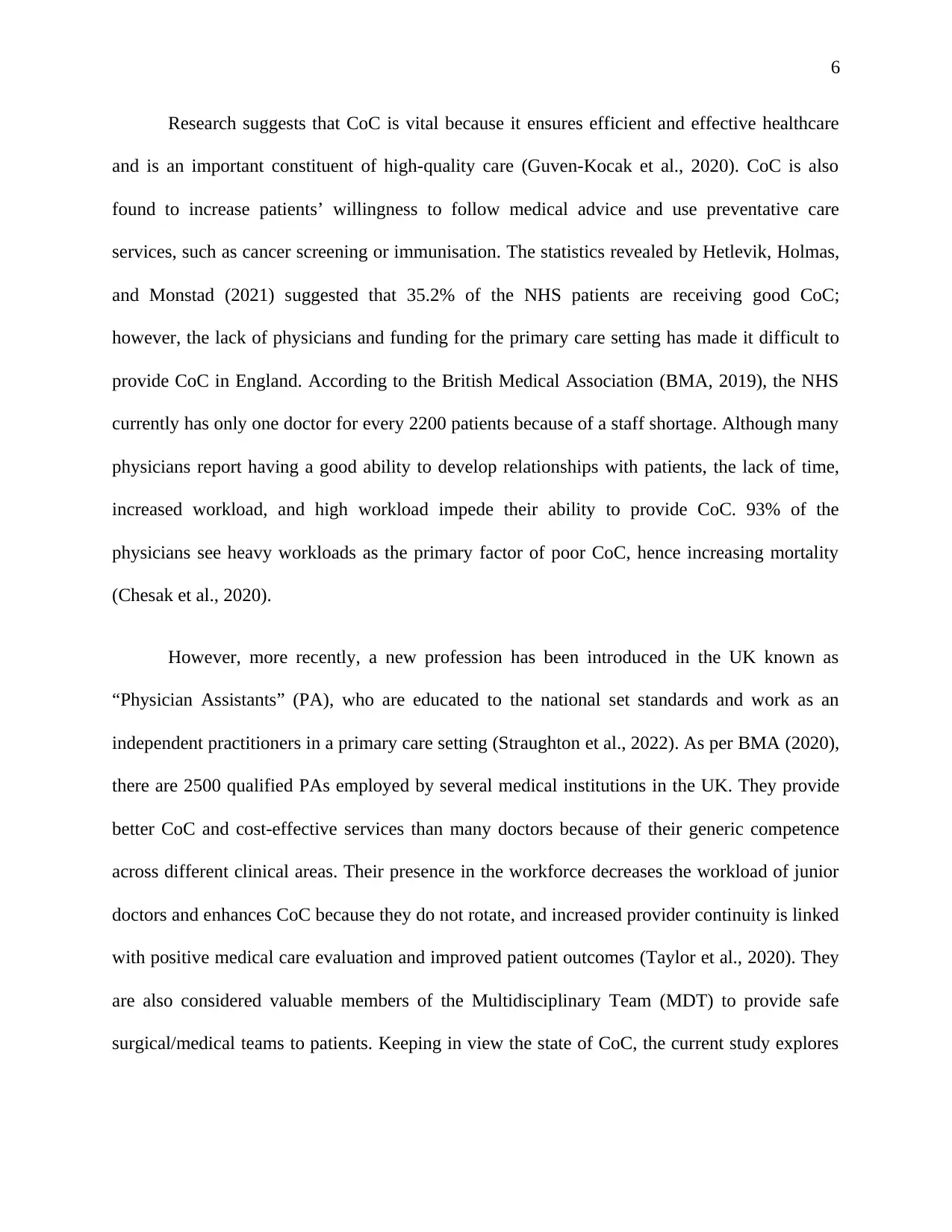
6
Research suggests that CoC is vital because it ensures efficient and effective healthcare
and is an important constituent of high-quality care (Guven-Kocak et al., 2020). CoC is also
found to increase patients’ willingness to follow medical advice and use preventative care
services, such as cancer screening or immunisation. The statistics revealed by Hetlevik, Holmas,
and Monstad (2021) suggested that 35.2% of the NHS patients are receiving good CoC;
however, the lack of physicians and funding for the primary care setting has made it difficult to
provide CoC in England. According to the British Medical Association (BMA, 2019), the NHS
currently has only one doctor for every 2200 patients because of a staff shortage. Although many
physicians report having a good ability to develop relationships with patients, the lack of time,
increased workload, and high workload impede their ability to provide CoC. 93% of the
physicians see heavy workloads as the primary factor of poor CoC, hence increasing mortality
(Chesak et al., 2020).
However, more recently, a new profession has been introduced in the UK known as
“Physician Assistants” (PA), who are educated to the national set standards and work as an
independent practitioners in a primary care setting (Straughton et al., 2022). As per BMA (2020),
there are 2500 qualified PAs employed by several medical institutions in the UK. They provide
better CoC and cost-effective services than many doctors because of their generic competence
across different clinical areas. Their presence in the workforce decreases the workload of junior
doctors and enhances CoC because they do not rotate, and increased provider continuity is linked
with positive medical care evaluation and improved patient outcomes (Taylor et al., 2020). They
are also considered valuable members of the Multidisciplinary Team (MDT) to provide safe
surgical/medical teams to patients. Keeping in view the state of CoC, the current study explores
Research suggests that CoC is vital because it ensures efficient and effective healthcare
and is an important constituent of high-quality care (Guven-Kocak et al., 2020). CoC is also
found to increase patients’ willingness to follow medical advice and use preventative care
services, such as cancer screening or immunisation. The statistics revealed by Hetlevik, Holmas,
and Monstad (2021) suggested that 35.2% of the NHS patients are receiving good CoC;
however, the lack of physicians and funding for the primary care setting has made it difficult to
provide CoC in England. According to the British Medical Association (BMA, 2019), the NHS
currently has only one doctor for every 2200 patients because of a staff shortage. Although many
physicians report having a good ability to develop relationships with patients, the lack of time,
increased workload, and high workload impede their ability to provide CoC. 93% of the
physicians see heavy workloads as the primary factor of poor CoC, hence increasing mortality
(Chesak et al., 2020).
However, more recently, a new profession has been introduced in the UK known as
“Physician Assistants” (PA), who are educated to the national set standards and work as an
independent practitioners in a primary care setting (Straughton et al., 2022). As per BMA (2020),
there are 2500 qualified PAs employed by several medical institutions in the UK. They provide
better CoC and cost-effective services than many doctors because of their generic competence
across different clinical areas. Their presence in the workforce decreases the workload of junior
doctors and enhances CoC because they do not rotate, and increased provider continuity is linked
with positive medical care evaluation and improved patient outcomes (Taylor et al., 2020). They
are also considered valuable members of the Multidisciplinary Team (MDT) to provide safe
surgical/medical teams to patients. Keeping in view the state of CoC, the current study explores
⊘ This is a preview!⊘
Do you want full access?
Subscribe today to unlock all pages.

Trusted by 1+ million students worldwide
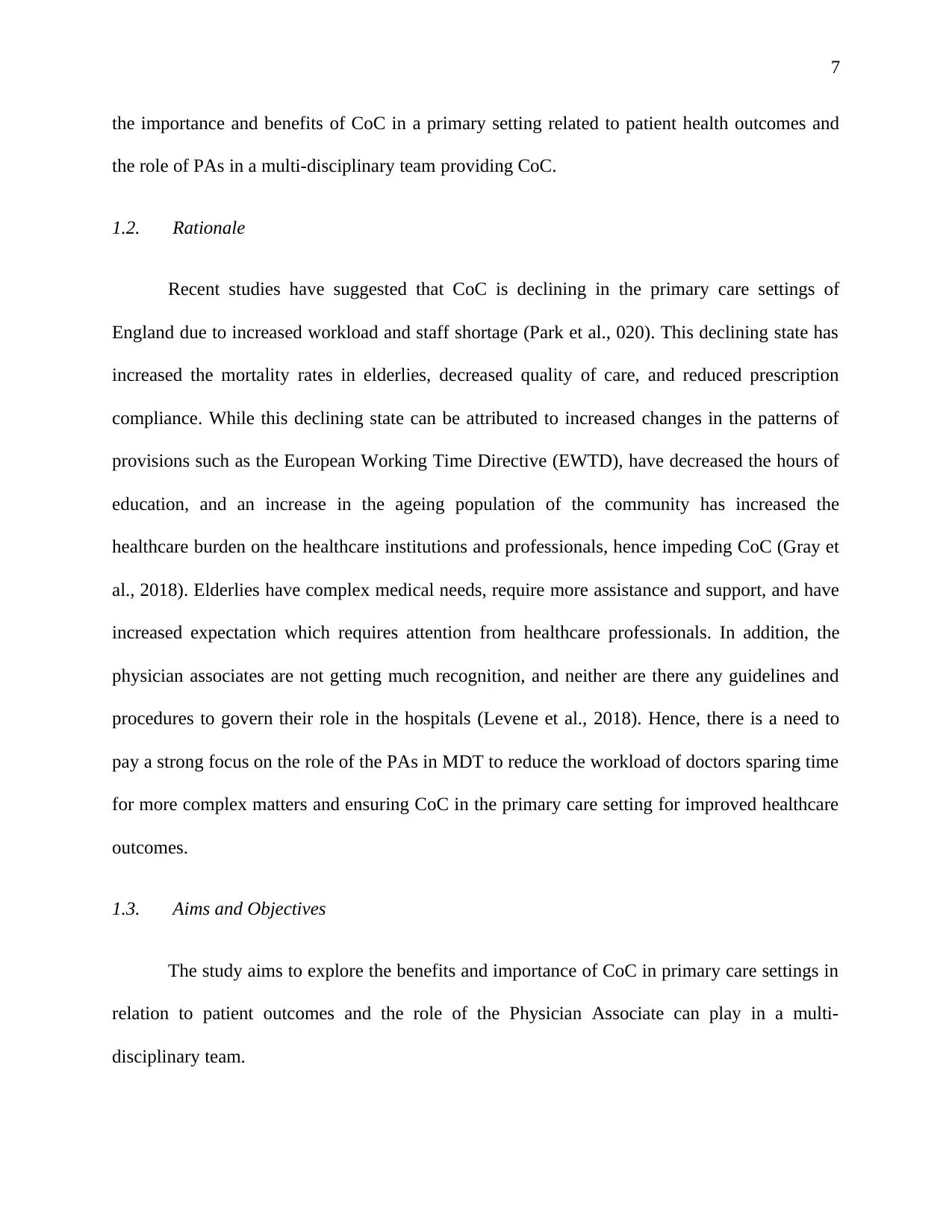
7
the importance and benefits of CoC in a primary setting related to patient health outcomes and
the role of PAs in a multi-disciplinary team providing CoC.
1.2. Rationale
Recent studies have suggested that CoC is declining in the primary care settings of
England due to increased workload and staff shortage (Park et al., 020). This declining state has
increased the mortality rates in elderlies, decreased quality of care, and reduced prescription
compliance. While this declining state can be attributed to increased changes in the patterns of
provisions such as the European Working Time Directive (EWTD), have decreased the hours of
education, and an increase in the ageing population of the community has increased the
healthcare burden on the healthcare institutions and professionals, hence impeding CoC (Gray et
al., 2018). Elderlies have complex medical needs, require more assistance and support, and have
increased expectation which requires attention from healthcare professionals. In addition, the
physician associates are not getting much recognition, and neither are there any guidelines and
procedures to govern their role in the hospitals (Levene et al., 2018). Hence, there is a need to
pay a strong focus on the role of the PAs in MDT to reduce the workload of doctors sparing time
for more complex matters and ensuring CoC in the primary care setting for improved healthcare
outcomes.
1.3. Aims and Objectives
The study aims to explore the benefits and importance of CoC in primary care settings in
relation to patient outcomes and the role of the Physician Associate can play in a multi-
disciplinary team.
the importance and benefits of CoC in a primary setting related to patient health outcomes and
the role of PAs in a multi-disciplinary team providing CoC.
1.2. Rationale
Recent studies have suggested that CoC is declining in the primary care settings of
England due to increased workload and staff shortage (Park et al., 020). This declining state has
increased the mortality rates in elderlies, decreased quality of care, and reduced prescription
compliance. While this declining state can be attributed to increased changes in the patterns of
provisions such as the European Working Time Directive (EWTD), have decreased the hours of
education, and an increase in the ageing population of the community has increased the
healthcare burden on the healthcare institutions and professionals, hence impeding CoC (Gray et
al., 2018). Elderlies have complex medical needs, require more assistance and support, and have
increased expectation which requires attention from healthcare professionals. In addition, the
physician associates are not getting much recognition, and neither are there any guidelines and
procedures to govern their role in the hospitals (Levene et al., 2018). Hence, there is a need to
pay a strong focus on the role of the PAs in MDT to reduce the workload of doctors sparing time
for more complex matters and ensuring CoC in the primary care setting for improved healthcare
outcomes.
1.3. Aims and Objectives
The study aims to explore the benefits and importance of CoC in primary care settings in
relation to patient outcomes and the role of the Physician Associate can play in a multi-
disciplinary team.
Paraphrase This Document
Need a fresh take? Get an instant paraphrase of this document with our AI Paraphraser
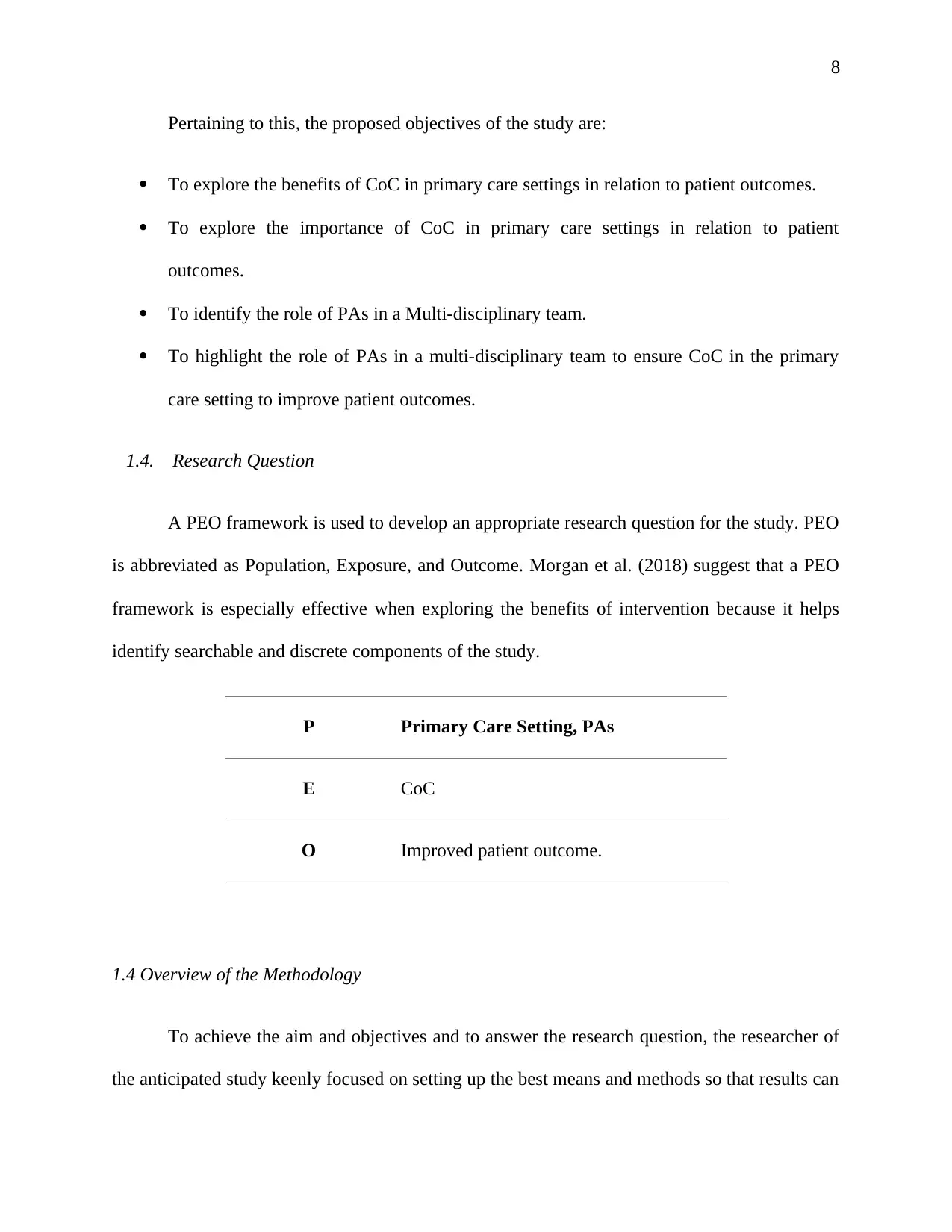
8
Pertaining to this, the proposed objectives of the study are:
To explore the benefits of CoC in primary care settings in relation to patient outcomes.
To explore the importance of CoC in primary care settings in relation to patient
outcomes.
To identify the role of PAs in a Multi-disciplinary team.
To highlight the role of PAs in a multi-disciplinary team to ensure CoC in the primary
care setting to improve patient outcomes.
1.4. Research Question
A PEO framework is used to develop an appropriate research question for the study. PEO
is abbreviated as Population, Exposure, and Outcome. Morgan et al. (2018) suggest that a PEO
framework is especially effective when exploring the benefits of intervention because it helps
identify searchable and discrete components of the study.
P Primary Care Setting, PAs
E CoC
O Improved patient outcome.
1.4 Overview of the Methodology
To achieve the aim and objectives and to answer the research question, the researcher of
the anticipated study keenly focused on setting up the best means and methods so that results can
Pertaining to this, the proposed objectives of the study are:
To explore the benefits of CoC in primary care settings in relation to patient outcomes.
To explore the importance of CoC in primary care settings in relation to patient
outcomes.
To identify the role of PAs in a Multi-disciplinary team.
To highlight the role of PAs in a multi-disciplinary team to ensure CoC in the primary
care setting to improve patient outcomes.
1.4. Research Question
A PEO framework is used to develop an appropriate research question for the study. PEO
is abbreviated as Population, Exposure, and Outcome. Morgan et al. (2018) suggest that a PEO
framework is especially effective when exploring the benefits of intervention because it helps
identify searchable and discrete components of the study.
P Primary Care Setting, PAs
E CoC
O Improved patient outcome.
1.4 Overview of the Methodology
To achieve the aim and objectives and to answer the research question, the researcher of
the anticipated study keenly focused on setting up the best means and methods so that results can
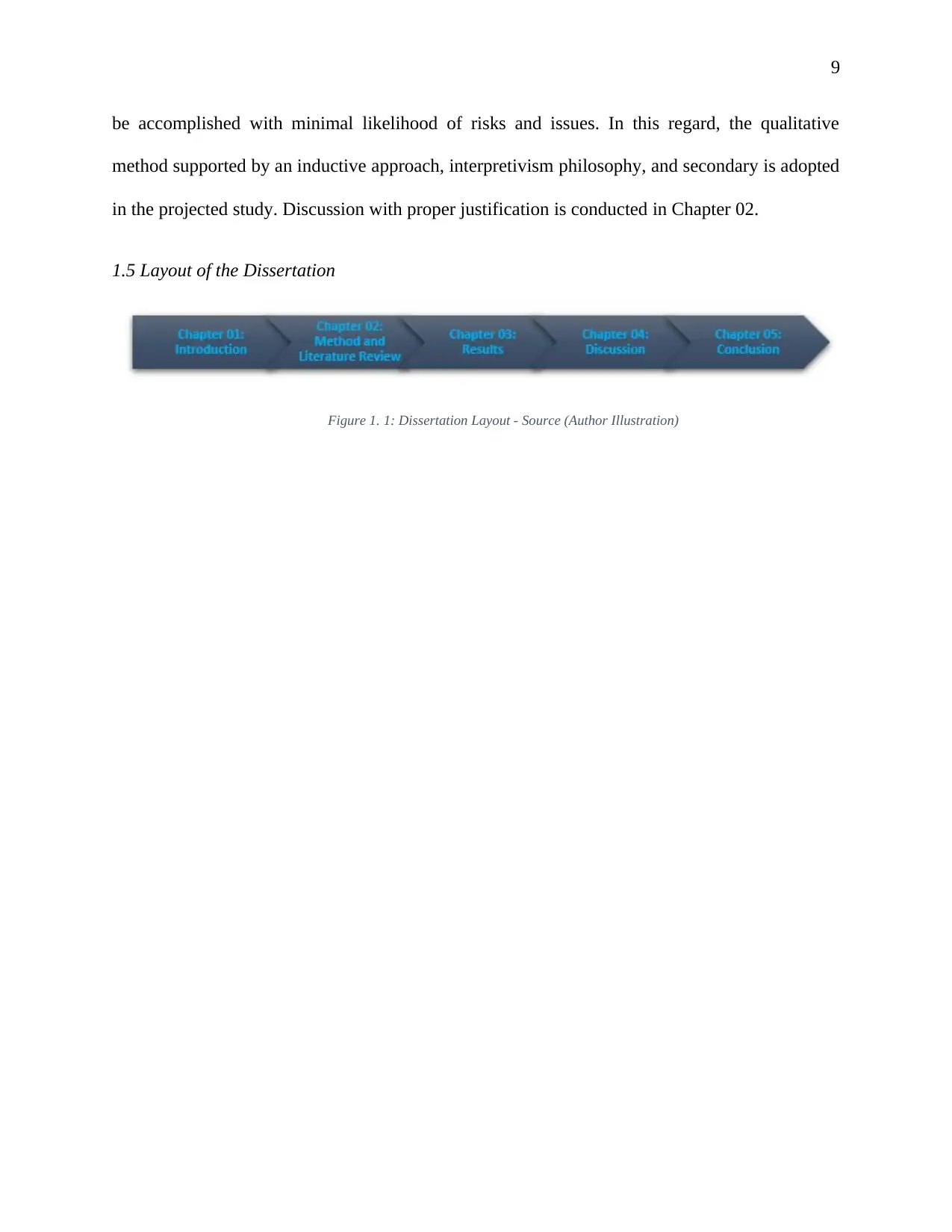
9
be accomplished with minimal likelihood of risks and issues. In this regard, the qualitative
method supported by an inductive approach, interpretivism philosophy, and secondary is adopted
in the projected study. Discussion with proper justification is conducted in Chapter 02.
1.5 Layout of the Dissertation
Figure 1. 1: Dissertation Layout - Source (Author Illustration)
be accomplished with minimal likelihood of risks and issues. In this regard, the qualitative
method supported by an inductive approach, interpretivism philosophy, and secondary is adopted
in the projected study. Discussion with proper justification is conducted in Chapter 02.
1.5 Layout of the Dissertation
Figure 1. 1: Dissertation Layout - Source (Author Illustration)
⊘ This is a preview!⊘
Do you want full access?
Subscribe today to unlock all pages.

Trusted by 1+ million students worldwide

10
Chapter 02: Methods and Literature Review
The proposed chapter of the entitled study is segregated into two sections, i.e., methods
and literature review. Both chapters are referred to as fundamentals of the research work and
support the researcher to form a better connection with the readers by discussing the methods
used to complete the research and discussing previous studies and their contribution to the
entitled topic.
Methods
This section includes a detailed discussion of the methods employed by the researcher to
conduct the study. For this purpose, this section highlights the research design, method,
approach, philosophy, data analysis technique, ethical considerations etc.
Research Design
Dannels (2018) defines research design as the complete strategy a researcher chooses to
integrate and link several aspects of a study logically and coherently to ensure that the developed
research question is adequately answered. Often, it is referred to as a draft describing the
research techniques, methods and strategies used by the researcher. Therefore, Sileyew (2019)
suggests that research design is divided into four sections: research philosophy, research
approach, research method, and data collection technique. It is also considered one of the four
basic pillars of research methodology. Hence, the researcher has acted accordingly, and in this
regard, secondary data collection technique, inductive approach, interpretivism philosophy, and
qualitative research methodology is adopted. The justification for the chosen research design has
been discussed in the subsequent sections.
Chapter 02: Methods and Literature Review
The proposed chapter of the entitled study is segregated into two sections, i.e., methods
and literature review. Both chapters are referred to as fundamentals of the research work and
support the researcher to form a better connection with the readers by discussing the methods
used to complete the research and discussing previous studies and their contribution to the
entitled topic.
Methods
This section includes a detailed discussion of the methods employed by the researcher to
conduct the study. For this purpose, this section highlights the research design, method,
approach, philosophy, data analysis technique, ethical considerations etc.
Research Design
Dannels (2018) defines research design as the complete strategy a researcher chooses to
integrate and link several aspects of a study logically and coherently to ensure that the developed
research question is adequately answered. Often, it is referred to as a draft describing the
research techniques, methods and strategies used by the researcher. Therefore, Sileyew (2019)
suggests that research design is divided into four sections: research philosophy, research
approach, research method, and data collection technique. It is also considered one of the four
basic pillars of research methodology. Hence, the researcher has acted accordingly, and in this
regard, secondary data collection technique, inductive approach, interpretivism philosophy, and
qualitative research methodology is adopted. The justification for the chosen research design has
been discussed in the subsequent sections.
Paraphrase This Document
Need a fresh take? Get an instant paraphrase of this document with our AI Paraphraser
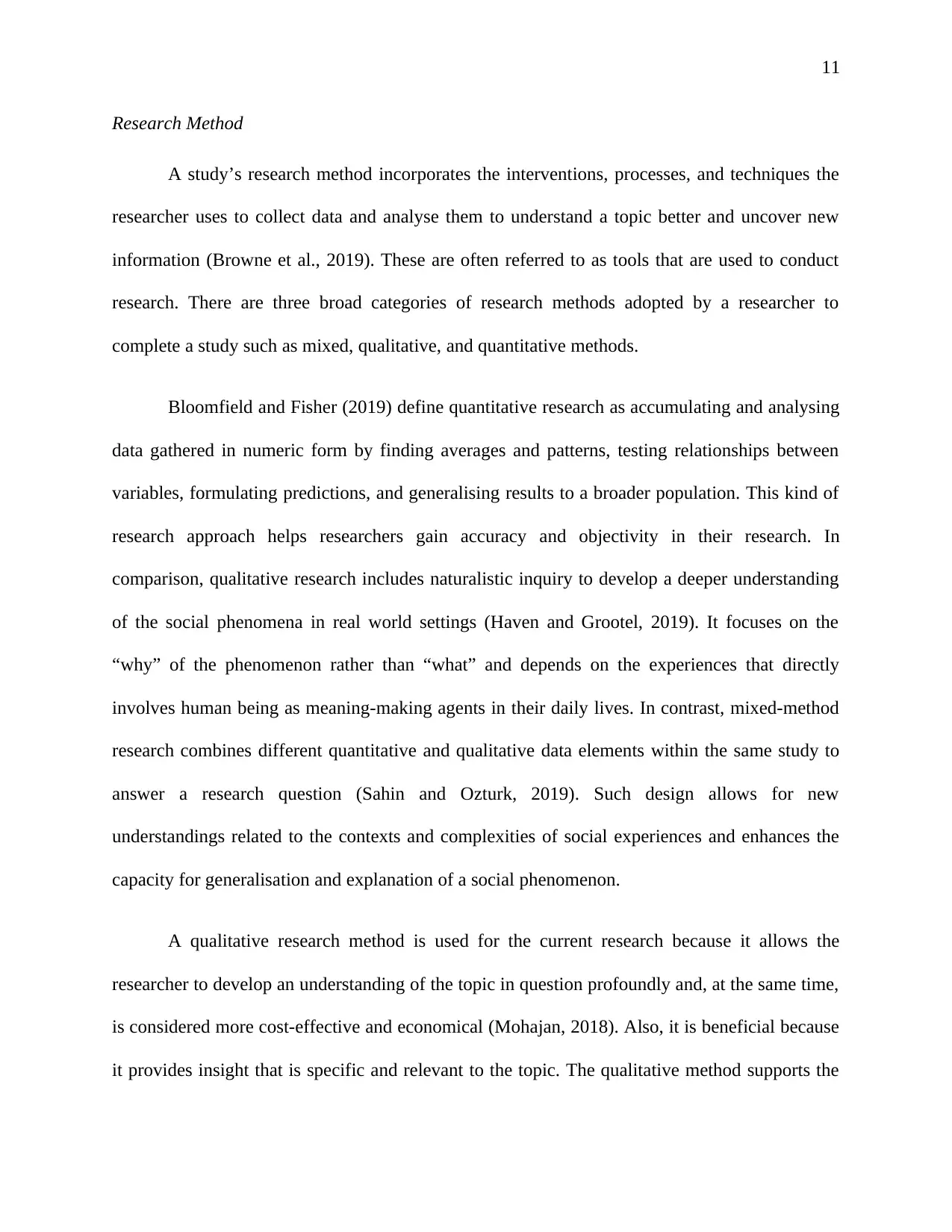
11
Research Method
A study’s research method incorporates the interventions, processes, and techniques the
researcher uses to collect data and analyse them to understand a topic better and uncover new
information (Browne et al., 2019). These are often referred to as tools that are used to conduct
research. There are three broad categories of research methods adopted by a researcher to
complete a study such as mixed, qualitative, and quantitative methods.
Bloomfield and Fisher (2019) define quantitative research as accumulating and analysing
data gathered in numeric form by finding averages and patterns, testing relationships between
variables, formulating predictions, and generalising results to a broader population. This kind of
research approach helps researchers gain accuracy and objectivity in their research. In
comparison, qualitative research includes naturalistic inquiry to develop a deeper understanding
of the social phenomena in real world settings (Haven and Grootel, 2019). It focuses on the
“why” of the phenomenon rather than “what” and depends on the experiences that directly
involves human being as meaning-making agents in their daily lives. In contrast, mixed-method
research combines different quantitative and qualitative data elements within the same study to
answer a research question (Sahin and Ozturk, 2019). Such design allows for new
understandings related to the contexts and complexities of social experiences and enhances the
capacity for generalisation and explanation of a social phenomenon.
A qualitative research method is used for the current research because it allows the
researcher to develop an understanding of the topic in question profoundly and, at the same time,
is considered more cost-effective and economical (Mohajan, 2018). Also, it is beneficial because
it provides insight that is specific and relevant to the topic. The qualitative method supports the
Research Method
A study’s research method incorporates the interventions, processes, and techniques the
researcher uses to collect data and analyse them to understand a topic better and uncover new
information (Browne et al., 2019). These are often referred to as tools that are used to conduct
research. There are three broad categories of research methods adopted by a researcher to
complete a study such as mixed, qualitative, and quantitative methods.
Bloomfield and Fisher (2019) define quantitative research as accumulating and analysing
data gathered in numeric form by finding averages and patterns, testing relationships between
variables, formulating predictions, and generalising results to a broader population. This kind of
research approach helps researchers gain accuracy and objectivity in their research. In
comparison, qualitative research includes naturalistic inquiry to develop a deeper understanding
of the social phenomena in real world settings (Haven and Grootel, 2019). It focuses on the
“why” of the phenomenon rather than “what” and depends on the experiences that directly
involves human being as meaning-making agents in their daily lives. In contrast, mixed-method
research combines different quantitative and qualitative data elements within the same study to
answer a research question (Sahin and Ozturk, 2019). Such design allows for new
understandings related to the contexts and complexities of social experiences and enhances the
capacity for generalisation and explanation of a social phenomenon.
A qualitative research method is used for the current research because it allows the
researcher to develop an understanding of the topic in question profoundly and, at the same time,
is considered more cost-effective and economical (Mohajan, 2018). Also, it is beneficial because
it provides insight that is specific and relevant to the topic. The qualitative method supports the
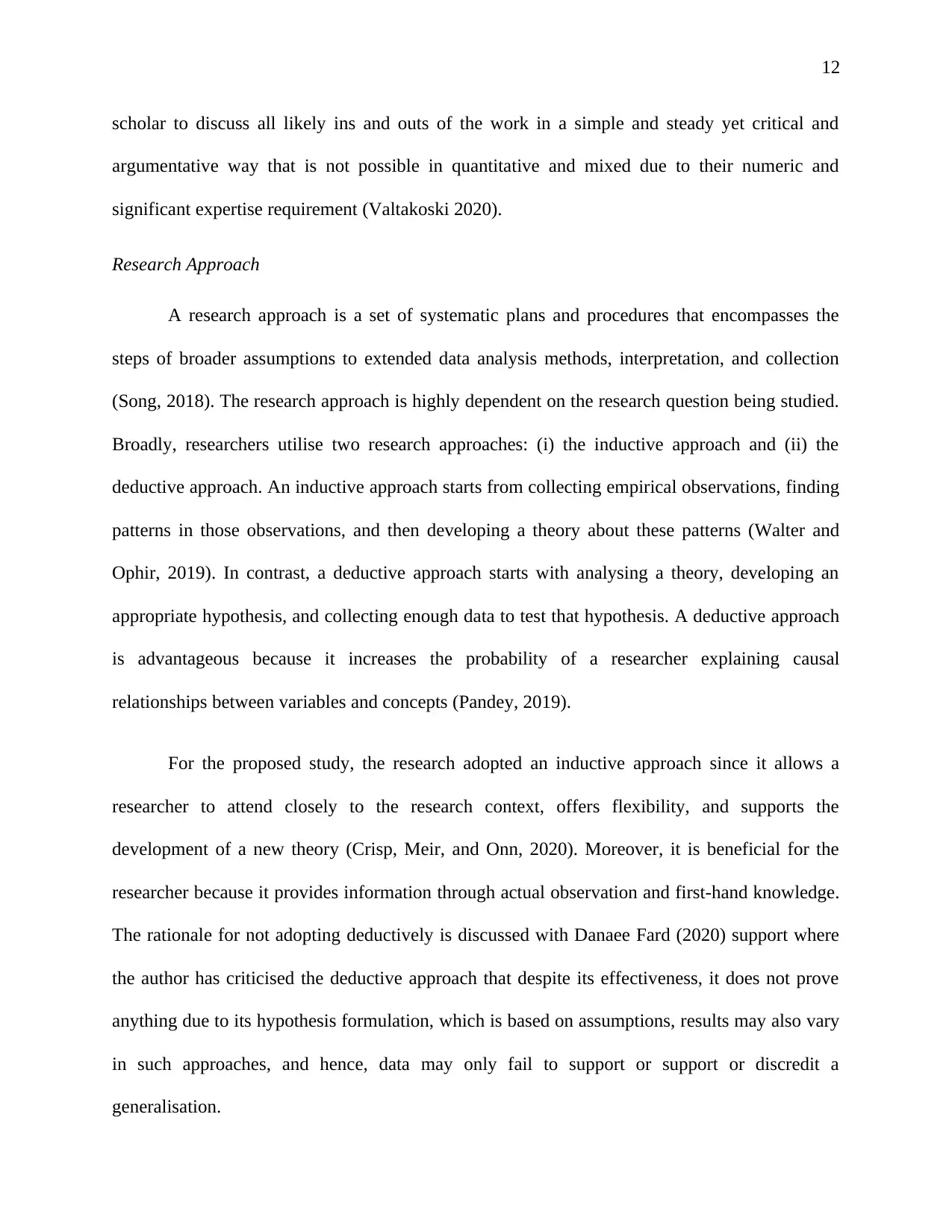
12
scholar to discuss all likely ins and outs of the work in a simple and steady yet critical and
argumentative way that is not possible in quantitative and mixed due to their numeric and
significant expertise requirement (Valtakoski 2020).
Research Approach
A research approach is a set of systematic plans and procedures that encompasses the
steps of broader assumptions to extended data analysis methods, interpretation, and collection
(Song, 2018). The research approach is highly dependent on the research question being studied.
Broadly, researchers utilise two research approaches: (i) the inductive approach and (ii) the
deductive approach. An inductive approach starts from collecting empirical observations, finding
patterns in those observations, and then developing a theory about these patterns (Walter and
Ophir, 2019). In contrast, a deductive approach starts with analysing a theory, developing an
appropriate hypothesis, and collecting enough data to test that hypothesis. A deductive approach
is advantageous because it increases the probability of a researcher explaining causal
relationships between variables and concepts (Pandey, 2019).
For the proposed study, the research adopted an inductive approach since it allows a
researcher to attend closely to the research context, offers flexibility, and supports the
development of a new theory (Crisp, Meir, and Onn, 2020). Moreover, it is beneficial for the
researcher because it provides information through actual observation and first-hand knowledge.
The rationale for not adopting deductively is discussed with Danaee Fard (2020) support where
the author has criticised the deductive approach that despite its effectiveness, it does not prove
anything due to its hypothesis formulation, which is based on assumptions, results may also vary
in such approaches, and hence, data may only fail to support or support or discredit a
generalisation.
scholar to discuss all likely ins and outs of the work in a simple and steady yet critical and
argumentative way that is not possible in quantitative and mixed due to their numeric and
significant expertise requirement (Valtakoski 2020).
Research Approach
A research approach is a set of systematic plans and procedures that encompasses the
steps of broader assumptions to extended data analysis methods, interpretation, and collection
(Song, 2018). The research approach is highly dependent on the research question being studied.
Broadly, researchers utilise two research approaches: (i) the inductive approach and (ii) the
deductive approach. An inductive approach starts from collecting empirical observations, finding
patterns in those observations, and then developing a theory about these patterns (Walter and
Ophir, 2019). In contrast, a deductive approach starts with analysing a theory, developing an
appropriate hypothesis, and collecting enough data to test that hypothesis. A deductive approach
is advantageous because it increases the probability of a researcher explaining causal
relationships between variables and concepts (Pandey, 2019).
For the proposed study, the research adopted an inductive approach since it allows a
researcher to attend closely to the research context, offers flexibility, and supports the
development of a new theory (Crisp, Meir, and Onn, 2020). Moreover, it is beneficial for the
researcher because it provides information through actual observation and first-hand knowledge.
The rationale for not adopting deductively is discussed with Danaee Fard (2020) support where
the author has criticised the deductive approach that despite its effectiveness, it does not prove
anything due to its hypothesis formulation, which is based on assumptions, results may also vary
in such approaches, and hence, data may only fail to support or support or discredit a
generalisation.
⊘ This is a preview!⊘
Do you want full access?
Subscribe today to unlock all pages.

Trusted by 1+ million students worldwide
1 out of 86
Related Documents
Your All-in-One AI-Powered Toolkit for Academic Success.
+13062052269
info@desklib.com
Available 24*7 on WhatsApp / Email
![[object Object]](/_next/static/media/star-bottom.7253800d.svg)
Unlock your academic potential
Copyright © 2020–2025 A2Z Services. All Rights Reserved. Developed and managed by ZUCOL.





